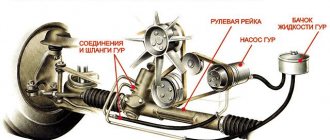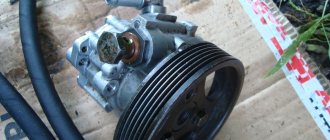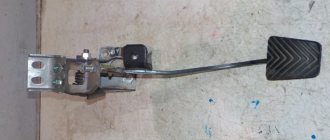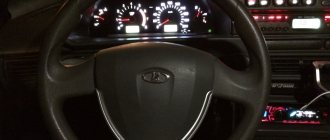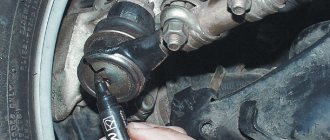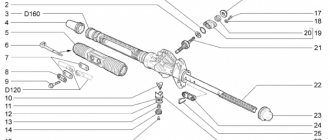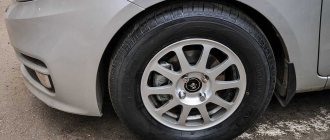Extraneous sounds, noises and even rattles are an integral part of any car after many years of operation. It is sounds and humming that are uncharacteristic of driving that can be considered clear signs of a breakdown or malfunction in any component of the vehicle.
In most cases, grinding and creaking do not indicate breakdowns, but the incorrect (faulty) operation of some mechanism. Often these problems are only detected under certain conditions - for example, when turning the steering wheel.
Front stabilizer
If the stabilizer link partially fails, a dull knock is heard when the wheels turn while moving. Moreover, the wheels begin to knock if they are turned to one side or the other at approximately 50...60%. However, a faulty strut itself can creak not only when turning, but also when the car is moving on an uneven road. Often the car also “fidgets” on the road, that is, it is necessary to constantly control (twist) the steering wheel. Additional signs - the car body rolls too much when entering a turn and sways when braking.
Knock (steering wheel turns, car turns)
This kind of sound accompanies the car when turning. It is noteworthy that often a small turning angle and a bad road make the car make such a knock more strongly. The reason for this behavior of the car is the wear of the shock absorbers, which no longer dampen road irregularities. In this case, only replacing with new racks will help. As a rule, the axle struts have different degrees of wear, so it is likely that a knocking noise is heard only when the steering wheel is rotated in only one direction.
A knock can occur not only when turning, but also when moving straight along a poor quality road. The maximum load on the racks occurs when the steering wheel is turned, which is why the knocking sound is produced more often. Just in case, check the strut housings - they may contain oil smudges, which indicates an oil leak in the struts.
A car with a decent mileage (the word “decent” means different numbers depending on the model), the shock absorbers can fail (due to various factors). It would be useful to find out how susceptible your car is to this disease either in the official service center or in the appropriate forum dedicated to your car brand. You can also immediately go to a specialist to diagnose the racks.
Causes of knocking and solutions
Diagnosis of problems with the steering wheel
- A failed ball joint. In this case, it may simply burst. This entails the wheels turning inward or outward in an unnatural way. The car is unable to move on its own. The only way out is to replace the hinge with a new one.
- A failed grenade. If a knock is heard when turning the steering wheel to the right, then the left grenade is loaded. Naturally, to solve a problem such as a knocking noise when turning the steering wheel to the left, you should replace the right grenade and vice versa.
- Wear of stabilizer bushings. To solve the problem, you need to purchase silicone grease and simply spray it on the bushings.
- Steering rack malfunction or weakening. Diagnostics will help identify the problem and repair/replace the spare part.
- Loosening the engine crankcase protection bolts . To do this, you need to tighten the bolt, or replace it if the thread is broken. It is rare that a tap needs to be used to create a new thread.
- It is possible that after replacing the wheel the nut was not tightened properly , then a knocking noise may appear after an unsuccessful replacement, and over time it increases with vibration. The solution is to tighten the nuts to the desired torque.
- Considering the quality of spare parts and the conscience of sellers, a spring can easily burst . The solution to the problem lies in replacing it with a new spring.
- Leaking shock absorbers are another reason for the appearance of a characteristic knocking sound when the car squats. Replacing with a new shock absorber will help solve this problem.
Ball and CV joints
The ball joint, or rather its wear, can cause squeaks and knocks when turning the steering wheel, both in place and in motion. It is better to change the support immediately, because the danger of its complete failure at high speed is very, very high. The key to long service life of ball joints, like many other components of a car, is adequate driving, especially on roads that are so called, quite arbitrarily. Well, keeping an eye on the condition of the anthers can also significantly extend the service life of these units.
CV joint or constant velocity joint is directly involved in the transmission of torque from the gearbox to the wheel. And just one of the signs of CV joint failure is a crunching sound when turning the steering wheel; this is the needle bearing complaining of its hard lot. CV joints can be external and internal and, as a rule, it is the external hinges that crunch. If you know for sure that the cause of the crunching is in the constant velocity joint, then you should not panic right away. Sometimes the CV joint crunches five or even ten thousand kilometers and only then does it become necessary to replace it. Or perhaps you should change the boot, renew the CV joint lubrication and it will last for quite a long time.
Why is grinding heard and how to deal with it
If you hear a grinding noise when you turn the steering wheel, this indicates wear on the steering system joints or front suspension. To find out the exact cause, it is worth carrying out diagnostics at a service station and replacing the failed spare part.
Article on the topic: Gasket for the fuel pump: which is better
Noise can occur when turning the steering wheel: a grinding sound when driving, or when the car is stationary. The cause of this noise lies in the failure of the support bearings of the strut or lower ball joint.
If you hear a grinding noise in the wheel when you turn the steering wheel, there can be many reasons. Experienced drivers advise contacting a car mechanic, driving the car into an inspection pit and having a look. Among the reasons are:
- The rubber on the cardan outboard bearing is torn. Stones and rubble can get into it;
- The grinding noise may occur when the pads rub against the discs;
- Another reason could be a loose locking ring.
In sub-zero weather, when turning the steering wheel all the way, a grinding noise is heard due to lack of lubrication. In this case, additional application of lubricant will help.
How to diagnose?
Why do you hear a rubber squeak when you turn the steering wheel? To answer this question, you need to check all possible reasons. It can squeak anywhere. Therefore, when carrying out diagnostic actions, be sure to clarify where the sound is coming from. This will make it easier to find the breakdown. But even after identifying the reason, check all other details. They may also be damaged. To identify the source of the squeak, you need to drive the car into an inspection hole. The assistant turns the steering wheel, and you listen to where the sound is coming from.
Wheel alignment angles
. If the squeak comes from the rubber, and only when driving while the car is stationary. The reason is most likely due to incorrect wheel installation. Visit a service where there are specialists in such adjustments. Do not delay in eliminating the cause. An incorrect installation angle leads to uneven tire wear. Moreover, they can become completely unusable quite quickly.
Steering column
. It is easy to establish that the creaking comes from it. The sound will be superficial, and you will often feel vibration and impacts in the steering wheel. The column coupling may creak. Just lubricate it and everything will be back to normal. Often the cause of a squeak is a bent steering column. The problem arises after accidents and unsuccessful repairs. This can only be eliminated by replacement. But this does not affect the driving performance. If the noise is not strong, then you can drive without fear.
Steering rack
. It rarely creaks. But this still happens. The creaking can be produced by the articulation of the rack and column. This happens due to wear or simply poor adjustment. First, try adjusting the mechanism. But this is not possible on all car models. Therefore, start by studying the manuals on this issue.
Tie Rod Ends
. These parts creak if the boot is damaged. In this case, dirt and sand get into the finger. This is what causes the creaking. Moreover, this sound can appear not only when driving, but also when driving over uneven roads. The problem is identified visually by inspecting the tips. It is recommended to change these parts on both sides at the same time.
Silent blocks
. These suspension elements usually begin to creak in extreme heat. And this is not always a sign of their malfunction. This is the first symptom of a future malfunction. Typically, this manifests itself on parts made of rubber. It dries at high temperatures and shrinks slightly in size. This is why there may be a squeaking sound.
To avoid this, it is recommended to install polyurethane parts. If such a squeak appears, carefully inspect the silent blocks. If there is no visible damage to the part, you can continue driving. As the temperature drops, this unpleasant symptom will go away.
Bearing problems
. The bearing in the steering knuckle will squeak. This also occurs when turning the steering wheel. A squeak appears when there is a lack of lubrication or grains of sand get into it. At the same time, the bearing may heat up, but this is not necessary. Add lubricant and adjust it.
Plastic
. The steering column of a modern car is located in a plastic, decorative casing. On budget models, the plastic is prone to crickets. Therefore, when you turn the steering wheel, various sounds may appear. This can be eliminated in various ways. It all depends on the car model.
Other reasons
When the driver realizes that his steering wheel is creaking when turning, he begins to look for the cause. However, the malfunction may lie in different elements of the car system. Specific car brands have their own specific reasons, which are not discussed in this article. The variety of steering systems is so great that there are many causes of malfunction.
In any case, whatever the cause of the problem, it must be eliminated as soon as possible. And it will be good if a professional does this. It's best to see a mechanic as soon as you notice any warning signs that could indicate a problem with your power steering or other critical components. Underestimating minor problems can lead to their aggravation and complete destruction of the system, which is associated with expensive repairs.
Knock (the steering wheel turns, but there is play)
Typically, the joints found in the steering system last as long as your car drives. However, under Russian operating conditions, faster wear is possible. Turning the steering wheel, accompanied by a faint knock at the beginning of rotation, indicates that the hinges are worn out (an increased gap has appeared). If you park the car on a level surface, then try to rotate the role from right to left, then from left to right (you need to start carefully with small movements), you can identify at what point in time the play and knocking sound appears. You can improve this method a little - open the car doors, then with the doors open, while outside the car, gradually turn the steering wheel from side to side. At some point in time, you will notice that the steering wheel rotates, but the wheels do not move - this means there is play. This backlash needs to be eliminated.
This can be done by diagnosing the hinges at a car repair shop (you need to check for wear and play), after which you need to replace the worn elements and tighten the necessary components that are causing the play.
When the shock absorber is faulty
Sometimes the cause of the noise is the creaking of the support bearing when turning the steering wheel. If creaking and howling noises occur no matter which way you turn, check the shock absorbers. Often the problem is in the bearings of this unit. It may be enough to remove any dirt that has clogged up under the boot. How to diagnose? Read on.
Try turning the steering wheel while standing still. Even better, ask an assistant to “steer”, while you listen and watch the movement of the shock absorber spring into the gap between the upper edge of the tire and the wing arch. If the part turns jerkily, as if something is interfering with it, it means that the support bearing creaks when turning the steering wheel. It's simple. There is no movement - neither the transmission nor the hubs can make noise - the shafts and wheels do not rotate. In this case, the only thing to suspect is the shock absorber struts.
Causes of creaking rack and steering column
If the steering column is not working properly, you will hear a slight knock and noticeable vibration when driving. The cause of this malfunction is a strong mechanical impact on the steering wheel, during sudden braking or a collision during an accident. Such signs indicate deformation of the steering column. Also, strange sounds may come from the coupling.
Of course, the best way to eliminate a squeaking or knocking sound when moving and turning the steering column is to simply replace the non-functioning element with a new part. Unfortunately, the steering column is expensive, which means you need to look for ways to repair the old part. Vibration and noise can be eliminated using lubricant. Lubricating the driveshaft with a small amount of grease can eliminate unwanted noise, but this will only mask the symptoms. It is important to seek help from professionals who can fix the broken part before it completely fails.
Steering knuckle bearings
If, when turning the steering wheel, the driver hears an uncharacteristic squeak, which can sometimes appear quite suddenly, it is worth listening to the steering knuckle.
When the sound comes from there, the cause most likely lies in worn bearings.
These bearings can squeak and make cracking noises if there is no lubricant inside or if sand or other abrasive contaminants have entered the housing.
Untimely replacement can have dangerous consequences. It is recommended to remove the bearing from the steering knuckle and check it for defects. If they are not there, lubricant is added and the part is returned to its place. If defects are detected, a new bearing similar to the previous one is used.
Replacing the ball joint
Tool for work:
- wrenches 17, 19;
- hammer;
- mount;
- puller;
- head for 12.
The ball joint is being replaced
The car is put on the handbrake, the bolts of the wheel from which the ball joint will be removed are loosened. Using a jack, the front part of the Lada Kalina car is raised, the bolts and wheel are removed. Use a 19 wrench to unscrew the ball pin nut. Insert the puller and twist to release the support pin.
The support fastening bolts are removed using a 12mm socket. The lever is pressed down, the support is released and removed. There is another way to dismantle the ball joint: the brake disc is placed on a rigged brick, the jack is lowered slightly to relieve the lever. At this moment the rack rises up, the ball is released.
A large amount of lubricant must be added to the new support. The pin is put in place, the nut is tightened with a torque of 66-82 Nm. If the holes of the steering knuckle and the support coincide, the bolts are tightened. The procedure requires patience and considerable effort.
Problems with the steering rack
The main reason for annoying squeaking noises when turning the steering wheel is a faulty steering rack. Such a squeak can be annoying, and untimely repairs can damage the parts. Unwanted squeaking can occur due to simple wear of the mechanisms, damage to the rack box or wear of the steering tips, which can rub against the rods. In addition, damaged anthers can accumulate dirt and debris, which makes a nasty sound when the mechanism operates.
Also, the cause of an unwanted squeak may be an incorrect setting between the steering rack and the column. It is extremely difficult to make such an adjustment, since all machines have an individual adjustment system, and it is better to trust a specialist.
conclusions
Any vehicle is a complex system consisting of thousands of different components. Therefore, various kinds of noise can appear both due to serious problems in the mechanisms, and due to the weakening of any simple element in the interior.
However, the car owner must carefully monitor the appearance of various kinds of sound effects both while the car is moving and when turning the steering wheel while parked. After all, only timely diagnosis of a problem can be considered the key to successful repair and safe driving.
It should be borne in mind that any difficulties that arise with turning the steering wheel must be resolved immediately, since the problem may result in the failure of one of the elements of the control system and an accident. You should not ignore the appearance of sounds uncharacteristic of vehicle operation, since the safety and even lives of people depend on it.
Sounds on cars with hydraulic booster
The power steering mechanism consists of the same parts and trapezoids, only the rack has special oil channels. Through them, oil under pressure acts on the steering rods, which makes it easier to turn the wheels.
– wear of the impeller of the power steering pump itself;
– jamming of the power steering pump;
– broken boots in the steering rack (it will start to leak);
– wear of the power pump drive pulley.
This kind of trouble happens even when the steering is working properly. In a strong eversion of the wheels, the load on the power steering pump becomes large. Especially when the car is loaded. The sound occurs due to increased wear on the drive pulley or belt.
Problems with electric power steering
Unlike hydraulic steering, the wheels are turned using an electric motor. It is connected to the steering mechanism by a belt drive. On VAZ-2127 cars, control with an electric amplifier is installed. Creaking when turning the steering wheel in place (Priora as well) is possible for the following reasons:
— wear of the electric motor pulley and steering mechanism;
— low voltage in the network;
— lack of “mass” of the car;
— malfunction of the electrical control unit.
Tie rods and tie rods
Due to natural wear and tear, the lugs and rods may, over time, become loose and squeak and make knocking noises when turning the machine. To diagnose, you need to jack up the car on the side where the annoying sound is coming from and first remove the wheel. Next, you need to shake the rods and tips and check for any play in them. It often happens that the boot on the tip breaks, which means dirt and moisture gets inside. This causes a corresponding knock.
There are cases when, for example, when performing a wheel alignment operation, a car enthusiast or master forgets to tighten the fastening nut between the steering rod and the steering tip. Accordingly, when you turn the steering wheel, both in motion and at a standstill, a loud metallic knock will be heard. You can determine more precisely if you shake the front wheel left and right with your hands, it will dangle and make similar sounds.
The steering wheel on the Priora creaks like hell
on the verge of biting. It started with the arrival of this summer’s warmth, almost instantly. It feels like some kind of rubber band is being pressed very hard against the steering shaft. The steering wheel is a little jerky
